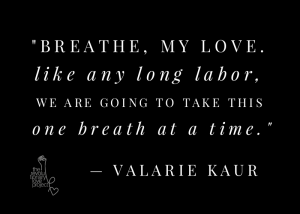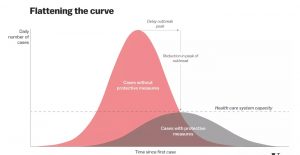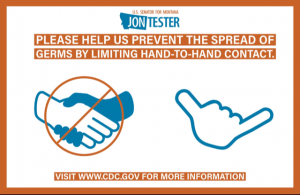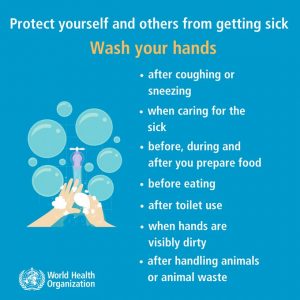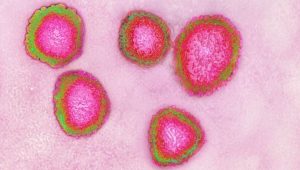Coronavirus
The other side of the virus.
March 24, 2020A poem from a Jesuit priest.
The Other Side of the Virus,
An Opportunity to Awaken…
Yes there is panic buying.
Yes there is sickness.
Yes there is even death.But,
They say that in Wuhan after so many years of noise
You can hear the birds again.They say that after just a few weeks of quiet
The sky is no longer thick with fumes
But blue and grey and clear.They say that in the streets of Assisi
People are singing to each other
across the empty squares,
keeping their windows open
so that those who are alone
may hear the sounds of family around them.They say that a hotel in the West of Ireland
is offering free meals and delivery to the housebound.Today a young woman I know
is busy spreading fliers with her number
through the neighbourhood
so that the elders may have someone to call on.Today Churches, Synagogues, Mosques and Temples
are preparing to welcome
and shelter the homeless, the sick, the weary.All over the world people are slowing down and reflecting.
All over the world people are looking at their neighbours in a new way.
All over the world people are waking up to a new reality
To how big we really are.
To how little control we really have.
To what really matters.
To Love.So we pray and we remember that
Yes there is fear.
But there does not have to be hate.Yes there is isolation.
But there does not have to be loneliness.Yes there is panic buying.
But there does not have to be meanness.Yes there is sickness.
But there does not have to be disease of the soulYes there is even death.
But there can always be a rebirth of love.Wake to the choices you make as to how to live now.
Today, breathe.
Listen, behind the factory noises of your panic-
The birds are singing again
The sky is clearing,
Spring is coming,And we are always encompassed by Love.
Open the windows of your soul
And though you may not be able
to touch across the empty square,Sing.
– Written by Fr. Richard Hendrick
Cultural Corona
March 17, 2020“Without trust and global solidarity we will not be able to stop the coronavirus epidemic we will not be able to stop the coronavirus epidemic, and we are likely to see more such epidemics in the future. But every crisis is also an opportunity.
-Yuval Noah Harari
Noah Harari is a historian, philosopher and the bestselling author of Sapiens, Homo Deusand 21 Lessons for the 21st Century.
Perhaps the most important thing people should realize about such epidemics, is that the spread of the epidemic in any country endangers the entire human species. This is because viruses evolve. Viruses like the corona originate in animals, such as bats. When they jump to humans, initially the viruses are ill-adapted to their human hosts. While replicating within humans, the viruses occasionally undergo mutations. Most mutations are harmless. But every now and then a mutation makes the virus more infectious or more resistant to the human immune system – and this mutant strain of the virus will then rapidly spread in the human population. Since a single person might host trillions of virus particles that undergo constant replication, every infected person gives the virus trillions of new opportunities to become more adapted to humans. Each human carrier is like a gambling machine that gives the virus trillions of lottery tickets – and the virus needs to draw just one winning ticket in order to thrive.
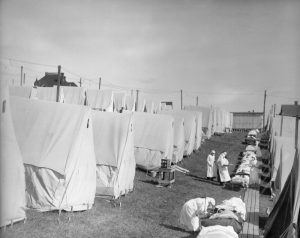
(Original Caption) Photo shows a scene in the influenza Camp at Lawrence, Maine, where patients are given fresh air treatment. this extreme measure was hit upon as the best way of curbing the epidemic. Patients are required to live in these camps until cured.
As you read these lines, perhaps a similar mutation is taking place in a single gene in the coronavirus that infected some person in Tehran, Milan or Wuhan. If this is indeed happening, this is a direct threat not just to Iranians, Italians or Chinese, but to your life, too. People all over the world share a life-and-death interest not to give the coronavirus such an opportunity. And that means that we need to protect every person in every country.
[…]
Today humanity faces an acute crisis not only due to the coronavirus, but also due to the lack of trust between humans. To defeat an epidemic, people need to trust scientific experts, citizens need to trust public authorities, and countries need to trust each other. Over the last few years, irresponsible politicians have deliberately undermined trust in science, in public authorities and in international cooperation. As a result, we are now facing this crisis bereft of global leaders that can inspire, organize and finance a coordinated global response.
[…]
What does this history teach us for the current Coronavirus epidemic?
First, it implies that you cannot protect yourself by permanently closing your borders. Remember that epidemics spread rapidly even in the Middle Ages, long before the age of globalization. So even if you reduce your global connections to the level of England in 1348 – that still would not be enough. To really protect yourself through isolation, going medieval won’t do. You would have to go full Stone Age. Can you do that?
Secondly, history indicates that real protection comes from the sharing of reliable scientific information, and from global solidarity. When one country is struck by an epidemic, it should be willing to honestly share information about the outbreak without fear of economic catastrophe – while other countries should be able to trust that information, and should be willing to extend a helping hand rather than ostracize the victim. Today, China can teach countries all over the world many important lessons about coronavirus, but this demands a high level of international trust and cooperation.
[…]
In this moment of crisis, the crucial struggle takes place within humanity itself. If this epidemic results in greater disunity and mistrust among humans, it will be the virus’s greatest victory. When humans squabble – viruses double. In contrast, if the epidemic results in closer global cooperation, it will be a victory not only against the coronavirus, but against all future pathogens.
https://time.com/5803225/yuval-noah-harari-coronavirus-humanity-leadership/
VOX
Scientists warn we may need to live with social distancing for a year or more
Researchers say we face a horrible choice: practice social distancing for months or a year, or let hundreds of thousands die.
Life in America — and in many countries around the world — is changing drastically. We’re physically distanced from our favorite people, we’re avoiding our favorite public places, and many are financially strained or out of work. The response to the Covid-19 pandemic is infiltrating every aspect of life, and we’re already longing for it to end. But this fight may not end for months or a year or even more.
We’re in this because public health experts believe social distancing is the best way to prevent a truly horrific crisis: perhaps hundreds of thousands or more if our health care system is overwhelmed with severe Covid-19 cases, people who require ventilators and ICU beds that are now growing limited in supply.
“Some may look at [the guidelines] … and say, well, maybe we’ve gone a little bit too far,” said Dr. Anthony Fauci, director of the National Institute of Allergy and Infectious Diseases and a member of the White House coronavirus task force, at a Monday White House press conference. “They were well thought out. And the thing that I want to reemphasize … when you’re dealing with an emerging infectious diseases outbreak, you are always behind where you think you are if you think that today reflects where you really are.”
How long, then, until we’re no longer behind and are winning the fight against the novel coronavirus? The hard truth is that it may keep infecting people and causing outbreaks until there’s a vaccine or treatment to stop it.
“I think this idea … that if you close schools and shut restaurants for a couple of weeks, you solve the problem and get back to normal life — that’s not what’s going to happen,” says Adam Kucharski, an epidemiologist at the London School of Hygiene & Tropical Medicine and author of The Rules of Contagion, a book on how outbreaks spread. “The main message that isn’t getting across to a lot of people is just how long we might be in this for.”
Ugh, whyyyyy???
The reason we may be in for an extended period of disruption, Kucharski says, is that the main thing that seems to be working right now to fight this pandemic is severe social distancing policies.
Drop those measures — allow people to congregate in big groups again — while the virus is still out there, and it can start new outbreaks that gravely threaten public health, particularly the older and chronically ill people, those most vulnerable to severe illness. “There’s no way [the virus] is going to go away in the next few weeks,” he says.
The way things are looking now, we’ll need something to stop the virus to truly end the threat. That’s either a vaccine (there are some now entering clinical trials but it could be a year before they are approved) or herd immunity. This is when enough people have contracted the virus, and have become immune to it, to slow its spread.
Herd immunity is not guaranteed. Currently it’s unclear if, after a period of months or years, a person can lose their immunity and become reinfected with the virus (which would make achieving herd immunity more difficult). Also, herd immunity will come at the cost of millions of people becoming infected, and possibly millions of people dying.
A new scientific report stresses: Only the most severe distancing measures can prevent hundreds of thousands of deaths
A sobering new report from the COVID-19 Response Team at the Imperial College of London underscores the need to keep social distancing measures in place for a long period.
It outlines two scenarios for combating the spread of the outbreak. One is mitigation, which focuses on “slowing but not necessarily stopping epidemic spread.” Another is suppression, “which aims to reverse epidemic growth.”
In their analysis, isolation of confirmed cases and quarantine of older adults without social distancing would still result in hundreds of thousands of deaths, and an “eight-fold higher peak demand on critical care beds over and above the available surge capacity in both [Great Britain] and the US.”
(Remember, all projections of possible deaths come with uncertainty and are greatly dependent on how we respond. Estimates can change based on variables that are not quite yet understood: like the role kids play in transmitting the virus, and the potential for the virus to show seasonal effects.)
Bars and restaurants will become takeout-only, and businesses from movie theaters and casinos to gyms and beyond will be shuttered throughout New York, New Jersey, and Connecticut.
Jennifer Nuzzo, an epidemiologist at Johns Hopkins Center for Health Security, agrees that the social distancing measures might need to be in place for at least months. “I don’t think people are prepared for that and I am not certain we can bear it,” she writes in an email. “I have no idea what political leaders will decide to do. To me, even if this is needed, it seems unsustainable.” She adds that she might just be feeling pessimistic, but “it’s really hard for me to imagine this country staying home for months.”
“Once things get better, we will have to take a step-wise approach toward letting up on these measures and see how things go to prevent things from getting worse again,” says Krutika Kuppalli, an infectious disease physician and Emerging Leader in Biosecurity fellow at the Johns Hopkins University Center for Health Security.
We also don’t know how long we’re in for because we don’t know how bad the outbreak is in the US — due to the lack of testing.
It’s okay to be upset by all of this. And there are still a lot of unknowns about this virus, and how it will all play out. Perhaps the worst will spare us. But we still need to prepare for it and tap into our resiliency. Life may feel very hard and very stressful over the next several months. It’s a real burden, and you don’t have to like it. But know: This pandemic will end eventually. What we don’t yet know is when.
“Although we may have to be physically apart… we can come together in ways we never have before”
WHO chief Dr Tedros says to overcome the coronavirus pandemic the “spirit of human solidarity must become even more infectious than the virus”
‘How Can I Make You Care?’ BuzzFeed Reporter & Idaho Native On Culture & Coronavirus
Molly Wampler
Anne Helen Petersen is a senior culture writer at BuzzFeed News, She’s based in Montana. Petersen has been covering the culture of the coronavirus, specifically how Americans got to this point in the crisis and why so many of us are having a hard time convincing loved ones to care about this pandemic.
Her recent articles (How Millennials Are Talking To Their Boomer Relatives About The Coronavirus, i don’t know how to make you care about other people) have struck a chord with folks across the country.
She joins Idaho Matters from Montana to talk about what she’s learned reporting on this pandemic in the U.S.
BUZZFEED
How Millennials Are Talking To Their Boomer Relatives About The Coronavirus
The big issue? So many of them don’t want to consider themselves “old” or “vulnerable.”
“There’s a general attitude that we are making a big deal out of nothing. A lot of ‘we deal with the flu every year.’”
There are multiple reasons for this split in approach, from general disposition (preparedness-minded to I’ll-deal-with-it-when-I-have-to) to one’s primary source of news and information. Add in inconsistent messaging from the government and differing “recommendations” from state to state, and it’s easy to understand why people have developed such disparate attitudes about how to proceed in their daily lives. There’s so much that’s unknown about how exactly the spread of the coronavirus will impact the United States, save to observe what’s happened in places that immediately launched extensive testing and quarantine efforts (like Hong Kong and South Korea, both of which have significantly mitigated the disease’s spread) and those that took longer (Italy and Iran).
But here’s what is clear: Even though many people who contract the coronavirus will only experience flulike symptoms, 15% to 20% will develop serious, life-threatening symptoms that demand hospitalization. The statistics from the outbreak in China are incredibly useful in figuring out who’s most at risk: “older adults” (anyone over 60); anyone with heart disease, diabetes, or lung disease; and anyone who is “immunocompromised” (a group that includes about 10 million people in the US, including those with cancer, HIV, and organ transplant recipients).
At this point, the resistance seems to be divided into three overarching areas: misinformation, disidentification, and general stubbornness. Like other types of contemporary misinformation, inaccurate and fake stories about COVID-19 has been spreading most aggressively on Facebook — where, as my colleague Craig Silverman has pointed out, older people are often purposefully targeted by sites and pages trafficking in hyperpartisan rhetoric and straight-up falsehoods.
“My parents and grandparents are on an IV drip of Fox News directly to their brains and believe COVID-19 is a hoax being used as a weapon against the president.”
One person who’s been trying to get his grandfather to take the threat of COVID-19 seriously sent me a screenshot of his latest text, which featured a picture that he’d taken of an image on his own computer. The photo is of a whiteboard, with the dates of previous epidemics, and the caption “POSTED AT A DOCTORS OFFICE TODAY.” (The information in the image has been widely circulating across Facebook and Twitter, but has been officially debunked.) “I don’t think you have to be afraid of the coronavirus,” the grandfather said. “As this post says, diseases appear every year to disrupt the voting process. It is good to be cautious but I believe it’s just another of Satan’s tactics to prevent people from following Jesus.”
[…]
You can also attempt to show, not tell: Show what’s happening in Italy and how the hospitals are overwhelmed, despite full quarantine measures. Explain that if the same thing happens here, they’ll need to be prepared: with meds, with food, with supplies. (Then offer to help them get their hands on those items, as many might be reticent to navigate new systems, like online grocery ordering; one person told me it took an hour to complete her 96-year-old great-grandmother’s order, because she was specifying items like “five green bananas,” but it was worth it: She wasn’t going to the grocery store.)
[…]
Upsetting routine, and replacing it with social isolation for an unspecified amount of time — something that many older people work so hard to counteract — is incredibly difficult to stomach. You can make that easier by promising a whole lot of FaceTiming or video-chatting, and offering to show their friends how to do the same. One woman who works for a public health organization told me that she gradually seeded information to her grandparents and parents, getting them used to the idea of future self-quarantine, before they actually decided to take action.
Empty seats at Goodyear Ballpark in Goodyear, Arizona, March 12. The MLB suspended spring training due to the ongoing threat of the coronavirus outbreak. [Getty]
“My dad was harder,” she explained. “I had to emphasize just how much of a risk he was being to my mom by going out. And eventually I just told him that I know he doesn’t like to overreact, and just generally thinks he’s immune to things, but that I had never really asked him for a favor, and that I was now. I needed him to listen to me, even if he didn’t want to.”
“My mom told me, ‘We are not going to stop living,’ and I said, “That is the point!’”
In some cases, the only thing that will make people take action is others forcing them to. The woman whose immunocompromised mom wouldn’t stop volunteering at the hospital contacted me again today. “The hospital sent all the older volunteers home,” she said. “My mom was a little sad about it, but we had a good conversation about safety and being around for her grandkids.”
Our parents and grandparents have spent their lives being the ones giving us advice and telling us what to do. Reversing that dynamic can feel incredibly unnatural. But even if your parents or grandparents aren’t listening now, they’re going to need you later. Keep trying, keep talking — and, if all else fails, appeal to their parental instincts. “Telling my parents I’m scared has been helpful,” a woman named Mary told me. “They’re way more incentivized to protect me from the fear.” ●
[Important read-full link]
Cancel Everything
March 11, 2020The Atlantic
Social distancing is the only way to stop the coronavirus. We must start immediately.
The first fact is that, at least in the initial stages, documented cases of COVID-19 seem to increase in exponential fashion. On the 23rd of January, China’s Hubei province, which contains the city of Wuhan, had 444 confirmed COVID-19 cases. A week later, by the 30th of January, it had 4,903 cases. Another week later, by the 6th of February, it had 22,112.
The same story is now playing out in other countries around the world. Italy had 62 identified cases of COVID-19 on the 22nd of February. It had 888 cases by the 29th of February, and 4,636 by the 6th of March.
Because the United States has been extremely sluggish in testing patients for the coronavirus, the official tally of 604 likely represents a fraction of the real caseload. But even if we take this number at face value, it suggests that we should prepare to have up to 10 times as many cases a week from today, and up to 100 times as many cases two weeks from today.
The second fact is that this disease is deadlier than the flu, to which the honestly ill-informed and the wantonly irresponsible insist on comparing it. Early guesstimates, made before data were widely available, suggested that the fatality rate for the coronavirus might wind up being about 1 percent. If that guess proves true, the coronavirus is 10 times as deadly as the flu.
But there is reason to fear that the fatality rate could be much higher. According to the World Health Organization, the current case fatality rate—a common measure of what portion of confirmed patients die from a particular disease—stands at 3.4 percent. This figure could be an overstatement, because mild cases of the disease are less likely to be diagnosed. Or it could be an understatement, because many patients have already been diagnosed with the virus but have not yet recovered (and may still die).
When the coronavirus first spread to South Korea, many observers pointed to the comparatively low death rates in the country to justify undue optimism. In countries with highly developed medical systems, they claimed, a smaller portion of patients would die. But while more than half of all diagnosed patients in China have now been cured, most South Korean patients are still in the throes of the disease. Of the 7,478 confirmed cases, only 118 have recovered; the low death rate may yet rise.
Meanwhile, the news from Italy, another country with a highly developed medical system, has so far been shockingly bad. In the affluent region of Lombardy, for example, there have been 7,375 confirmed cases of the virus as of Sunday. Of these patients, 622 had recovered, 366 had died, and the majority were still sick. Even under the highly implausible assumption that all of the still-sick make a full recovery, this would suggest a case fatality rate of 5 percent—significantly higher, not lower, than in China.
The third fact is that so far only one measure has been effective against the coronavirus: extreme social distancing.
Before China canceled all public gatherings, asked most citizens to self-quarantine, and sealed off the most heavily affected region, the virus was spreading in exponential fashion. Once the government imposed social distancing, the number of new cases leveled off; now, at least according to official statistics, every day brings more news of existing patients who are healed than of patients who are newly infected.
A few other countries have taken energetic steps to increase social distancing before the epidemic reached devastating proportions. In Singapore, for example, the government quickly canceled public events and installed medical stations to measure the body temperature of passersby while private companies handed out free hand sanitizer. As a result, the number of cases has grown much more slowly than in nearby countries.
These three facts imply a simple conclusion. The coronavirus could spread with frightening rapidity, overburdening our health-care system and claiming lives, until we adopt serious forms of social distancing.
This suggests that anyone in a position of power or authority, instead of downplaying the dangers of the coronavirus, should ask people to stay away from public places, cancel big gatherings, and restrict most forms of nonessential travel.
Given that most forms of social distancing will be useless if sick people cannot get treated—or afford to stay away from work when they are sick—the federal government should also take some additional steps to improve public health. It should take on the costs of medical treatment for the coronavirus, grant paid sick leave to stricken workers, promise not to deport undocumented immigrants who seek medical help, and invest in a rapid expansion of ICU facilities.
The past days suggest that this administration is unlikely to do these things well or quickly (although the administration signaled on Monday that it will seek relief for hourly workers, among other measures). Hence, the responsibility for social distancing now falls on decision makers at every level of society.
Do you head a sports team? Play your games in front of an empty stadium.
Are you organizing a conference? Postpone it until the fall.
Do you run a business? Tell your employees to work from home.
Are you the principal of a school or the president of a university? Move classes online before your students get sick and infect their frail relatives.
Are you running a presidential campaign? Cancel all rallies right now.
All of these decisions have real costs. Shutting down public schools in New York City, for example, would deprive tens of thousands of kids of urgently needed school meals. But the job of institutions and authorities is to mitigate those costs as much as humanly possible, not to use them as an excuse to put the public at risk of a deadly communicable disease.
Finally, the most important responsibility falls on each of us. It’s hard to change our own behavior while the administration and the leaders of other important institutions send the social cue that we should go on as normal. But we must change our behavior anyway. If you feel even a little sick, for the love of your neighbor and everyone’s grandpa, do not go to work.
When the influenza epidemic of 1918 infected a quarter of the U.S. population, killing tens of millions of people, seemingly small choices made the difference between life and death.
As the disease was spreading, Wilmer Krusen, Philadelphia’s health commissioner, allowed a huge parade to take place on September 28; some 200,000 people marched. In the following days and weeks, the bodies piled up in the city’s morgues. By the end of the season, 12,000 residents had died.
In St. Louis, a public-health commissioner named Max Starkloff decided to shut the city down. Ignoring the objections of influential businessmen, he closed the city’s schools, bars, cinemas, and sporting events. Thanks to his bold and unpopular actions, the per capita fatality rate in St. Louis was half that of Philadelphia. (In total, roughly 1,700 people died from influenza in St Louis.)
In the coming days, thousands of people across the country will face the choice between becoming a Wilmer Krusen or a Max Starkloff.
In the moment, it will seem easier to follow Krusen’s example. For a few days, while none of your peers are taking the same steps, moving classes online or canceling campaign events will seem profoundly odd. People are going to get angry. You will be ridiculed as an extremist or an alarmist. But it is still the right thing to do.
Rupert Murdoch could save lives by forcing Fox News to tell the truth about coronavirus — right now
By
There’s one person who could transform all that in an instant: Fox founder Rupert Murdoch, the Australian-born media mogul who, at 89, still exerts his influence on the leading cable network — and thus on the president himself.
Chris Wallace, the independent and tough-minded Fox News interviewer who serves as the network’s chief reality officer, has revealed that the executive chairman of News Corp and co-chairman of Fox Corporation likes to give feedback on what he sees on the network.
“He cares tremendously about the news,” Wallace said, according to the Guardian. “When I have contact with him, he never is asking about ideology, just: ‘What’s going on? What’s happening? Tell me.’ ”
That’s a little hard to believe, given the network’s long history of Clinton-bashing and birtherism lies about Barack Obama, and its peddling of conspiracy theories. But Murdoch’s ultimate power at the network is not in question.
So imagine if the word flowed down from on high that Fox News should communicate to Trump that he needs to take an entirely new tack on the virus. Imagine if Murdoch ordered the network to end its habit of praising him as if he were the Dear Leader of an authoritarian regime and to instead use its influence to drive home the seriousness of the moment.
Would it matter? No doubt.
The network’s influence on Trump is clear from the presidential tweets that follow fast on the heels of a Fox News broadcast. He was always a fan of Fox News, but after entering the White House, he made it even more of an obsessive daily habit, Bloomberg News reported in 2017, to the extent of blotting out dissenting voices from other sources.
Trump made specific reference to his reliance on Fox News during his misleading press event Friday, when he offered unwarranted reassurance rather than urging extreme caution and decisive action: “As of the time I left the plane . . . we had 240 cases — that’s at least what was on a very fine network known as Fox News.”
The message: Go about your business, America, and it will all disappear soon.
Days later, 30 deaths and more than 1,000 cases have been reported in the United States, with those numbers expected to grow exponentially. (By contrast, German Chancellor Angela Merkel is telling hard truths: As much as 70 percent of that country could end up being infected.)
Matt Gertz, a Media Matters senior fellow and the foremost chronicler of the insidious Trump-Fox News feedback loop, connected the dots: “Roughly an hour before his comments, a Fox News medical correspondent argued on-air that coronavirus was no more dangerous than the flu; a few hours later, the same correspondent argued that coronavirus fears were being deliberately overblown in hopes of damaging Trump politically.”
He added: “The network’s personalities have frequently claimed that the Trump administration has been doing a great job responding to coronavirus, that the fears of the disease are overblown, and that the real problem is Democrats and the media politicizing the epidemic to prevent Trump’s reelection.”
On Fox Business Channel, host Trish Regan drew widespread condemnation for her over-the-top rant in Trump’s defense: “The chorus of hate being leveled at the president is nearing a crescendo as Democrats blame him and only him for a virus that originated halfway around the world. This is yet another attempt to impeach the president.”
(By contrast, her Fox News colleague Tucker Carlson has taken the threat seriously, though using it as an excuse to stoke anti-China sentiment along the way.)
But it’s not just the opinionators such as Regan and Trump whisperer Sean Hannity who are at fault. The news segments — while certainly more tied to reality — seldom push back in a meaningful way against the Trump message.
On Tuesday, news anchors Bret Baier and Martha MacCallum docilely sat back and lobbed soft questions while the president’s son Eric praised his father’s crisis-management skills and blamed liberal media figures who criticize him: “He could cure cancer tomorrow and they’d say it wasn’t fast enough.”
Even if all that changed today, great harm has already been done. As The Washington Post and others have documented, the administration has repeatedly squandered chances to prepare for and manage the global epidemic.
But every moment still counts. Lives can be saved by prudent practices and aggressive government action — and lost by their absence.
But it takes leadership from the top. And so, let’s acknowledge the obvious: There is no more important player in influencing Trump than Fox News. And no more powerful figure at Fox than its patriarch.
Murdoch might consider, too, that with the median age of Fox’s viewers around 65, they are among the most vulnerable to the virus’s threats.
For Fox News, a late-breaking change of heart might finally combine a wise business decision with what’s good for the world.
#FlattenTheCurve
March 10, 2020“Difficult problems are rarely solved immediately, and sometimes they’re not solved the way we might have imagined, but with effort, they often yield.” Seth Godin
“Someone made a really good point–many Americans are all about their “self-rights” rather than thinking of others. Look at vaccine fiasco. A wealthy family in St. Louis that was suppose to quarantine went to dad-daughter dance , shopping, and nail salon.” Ed Fuller, Associate Professor at Penn State
Epidemiologists call this strategy of preventing a huge spike in cases “flattening the curve,” and it looks like this:
VOX
According to infectious disease epidemiologist Marc Lipsitch at Harvard, it’s “plausible” that 20 to 60 percent of adults will be infected with Covid-19 disease. So far, 80 percent of cases globally have been mild, but if the case fatality rate is around 1 percent (which several experts say it may be), a scenario is possible of tens or hundreds of thousands of deaths in the US alone.
On Thursday, the CDC posted new guidance for people over age 60 and people with chronic medical conditions — the two groups considered most vulnerable to severe pneumonia from Covid-19 — to “avoid crowds as much as possible.”
At this point, with the virus spreading in America, the top priority is making sure the health care system avoids being flooded with very sick patients who need ventilators and intensive care.
But one thing people can do to help is stay home if they are feeling unwell and especially if they received a formal Covid-19 diagnosis and advice to self-quarantine. That way, the US health care system can focus on the patients who really need it during this outbreak.
Washington Post
“Two weeks of delay can mean the difference between success and failure. Public health experts learned this in 1918 when the Spanish flu killed 50 million to 100 million people around the globe. If we fail to take action, we will watch our health-care system be overwhelmed.
Because children are not among the groups most vulnerable to coronavirus, schools should be closed in an effort to reduce community transmission and to protect the children’s parents and grandparents. How long? Epidemiologists suggest eight weeks might be needed to arrest this outbreak.”
The United States and other liberal societies must mount a significant, coordinated response with public buy-in.
As the coronavirus shifts from containment to mitigation, I am finally able to engage my two superpowers — social distancing and self-quarantine. -Cynthia Sewell, Investigative Reporter for the Idaho Statesman
“The intersection of a complex, unexpected health crisis causing an unusual form of recession is exactly the kind of thing Elizabeth Warren would’ve been unusually good at handling.” -Journalist Ezra Klein
COVID-19
March 2, 2020Bill Gates sets grim tone on virus
Bill Gates, who has devoted much of his life and fortune to global health, warns in The New England Journal of Medicine that the coronavirus “has started behaving a lot like the once-in-a-century pathogen we’ve been worried about”:
The big picture: Gates, always an optimist, writes that in addition to responding to this crisis, “we also need to make larger systemic changes so we can respond more efficiently and effectively when the next epidemic arrives.”
New England Journal of Medicine article:
https://www.nejm.org/doi/full/10.1056/NEJMp2003762
From the World Health Organization [WHO]:
What every country should be asking itself
Discussing preparedness for COVID-19, the WHO Director-General listed questions every health minister should be able to answer. Here are a selection:
-
Are we ready for the first case?
-
Do we have enough medical oxygen, ventilators and other vital equipment?
-
How will we know if there are cases in other areas of the country?
-
Do our health workers have the training and equipment they need to stay safe?
-
Do we have the right measures at airports and border crossings to test people who are sick?
-
Do our labs have the right chemicals that allow them to test samples?
-
Are we ready to treat patients with severe or critical disease?
-
Do our hospitals and clinics have the right procedures to prevent and control infections?
-
Do our people have the right information? Do they know what the disease looks like?
Dr. Matt McCarthy, NY Presbyterian Hospital on Coronavirus:
“We are not testing at full capacity and that is a national scandal. We’re being told that things are ok…that’s just not the way we’re talking about it in medical circles.”
#CoronaOutbreak
Dr. Anthony Fauci, US director infectious disease:
“We’re dealing with clearly an emerging infectious disease that has now reached outbreak proportions and likely pandemic proportions.”
‘Last Week Tonight’ host Jon Oliver shared this video taking hold in Asia and shown in the 3.1.2020 episode.
https://www.youtube.com/watch?v=tZ_xLivVtjM
From comedian and late night host Jimmy Kimmell:
‘Washing your hands is very important. Jimmy wanted to make sure he was doing it right, so we got in touch with a doctor at the Mayo Clinic in Minnesota named Dr Poland. He is a specialist in infectious disease and he flew all the way to LA just to teach Jimmy and Guillermo how to wash.’
‘…because the government lied, more people died.’
February 28, 2020‘An expert on the 1918 Spanish Flu epidemic wrote a piece 2 yrs ago on lessons of why that outbreak was so deadly.
His conclusion: govt officials, desperate to keep morale up during WWI, didn’t tell the truth.
And because the government lied, more people died.’
-Ian Bassin, former associate White House Council
How the Horrific 1918 Flu Spread Across America
The toll of history’s worst epidemic surpasses all the military deaths in World War I and World War II combined. And it may have begun in the United States
Although some researchers argue that the 1918 pandemic began elsewhere, in France in 1916 or China and Vietnam in 1917, many other studies indicate a U.S. origin. The Australian immunologist and Nobel laureate Macfarlane Burnet, who spent most of his career studying influenza, concluded the evidence was “strongly suggestive” that the disease started in the United States and spread to France with “the arrival of American troops.” Camp Funston had long been considered as the site where the pandemic started until my historical research, published in 2004, pointed to an earlier outbreak in Haskell County.
Wherever it began, the pandemic lasted just 15 months but was the deadliest disease outbreak in human history, killing between 50 million and 100 million people worldwide, according to the most widely cited analysis. An exact global number is unlikely ever to be determined, given the lack of suitable records in much of the world at that time. But it’s clear the pandemic killed more people in a year than AIDS has killed in 40 years, more than the bubonic plague killed in a century.
The impact of the pandemic on the United States is sobering to contemplate: Some 670,000 Americans died.
A ravaged lung (at the National Museum of Health and Medicine) from a U.S. soldier killed by flu in 1918.(Cade Martin)
We are arguably as vulnerable—or more vulnerable—to another pandemic as we were in 1918. Today top public health experts routinely rank influenza as potentially the most dangerous “emerging” health threat we face. Earlier this year, upon leaving his post as head of the Centers for Disease Control and Prevention, Tom Frieden was asked what scared him the most, what kept him up at night. “The biggest concern is always for an influenza pandemic…[It] really is the worst-case scenario.” So the tragic events of 100 years ago have a surprising urgency—especially since the most crucial lessons to be learned from the disaster have yet to be absorbed.
Against this background, while influenza bled into American life, public health officials, determined to keep morale up, began to lie.
https://www.smithsonianmag.com/history/journal-plague-year-180965222/

